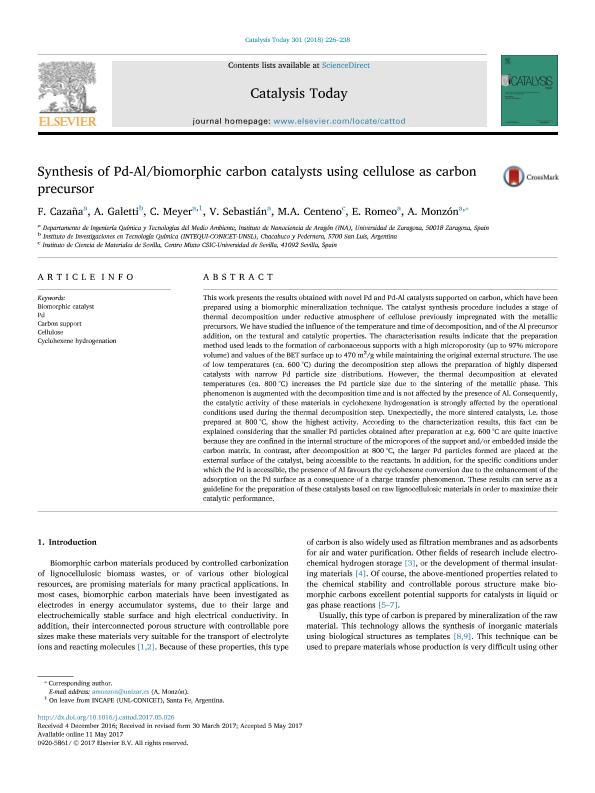Artículo
Synthesis of Pd-Al/biomorphic carbon catalysts using cellulose as carbon precursor
Cazaña, F.; Galetti, Agustin Esteban ; Meyer, Camilo Ignacio
; Meyer, Camilo Ignacio ; Sebastián, V.; Centeno, M.A.; Romeo, E.; Monzón, A.
; Sebastián, V.; Centeno, M.A.; Romeo, E.; Monzón, A.
 ; Meyer, Camilo Ignacio
; Meyer, Camilo Ignacio ; Sebastián, V.; Centeno, M.A.; Romeo, E.; Monzón, A.
; Sebastián, V.; Centeno, M.A.; Romeo, E.; Monzón, A.
Fecha de publicación:
03/2018
Editorial:
Elsevier Science
Revista:
Catalysis Today
ISSN:
0920-5861
Idioma:
Inglés
Tipo de recurso:
Artículo publicado
Clasificación temática:
Resumen
This work presents the results obtained with novel Pd and Pd-Al catalysts supported on carbon, which have been prepared using a biomorphic mineralization technique. The catalyst synthesis procedure includes a stage of thermal decomposition under reductive atmosphere of cellulose previously impregnated with the metallic precursors. We have studied the influence of the temperature and time of decomposition, and of the Al precursor addition, on the textural and catalytic properties. The characterisation results indicate that the preparation method used leads to the formation of carbonaceous supports with a high microporosity (up to 97% micropore volume) and values of the BET surface up to 470 m2/g while maintaining the original external structure. The use of low temperatures (ca. 600 °C) during the decomposition step allows the preparation of highly dispersed catalysts with narrow Pd particle size distributions. However, the thermal decomposition at elevated temperatures (ca. 800 °C) increases the Pd particle size due to the sintering of the metallic phase. This phenomenon is augmented with the decomposition time and is not affected by the presence of Al. Consequently, the catalytic activity of these materials in cyclohexene hydrogenation is strongly affected by the operational conditions used during the thermal decomposition step. Unexpectedly, the more sintered catalysts, i.e. those prepared at 800 °C, show the highest activity. According to the characterization results, this fact can be explained considering that the smaller Pd particles obtained after preparation at e.g. 600 °C are quite inactive because they are confined in the internal structure of the micropores of the support and/or embedded inside the carbon matrix. In contrast, after decomposition at 800 °C, the larger Pd particles formed are placed at the external surface of the catalyst, being accessible to the reactants. In addition, for the specific conditions under which the Pd is accessible, the presence of Al favours the cyclohexene conversion due to the enhancement of the adsorption on the Pd surface as a consequence of a charge transfer phenomenon. These results can serve as a guideline for the preparation of these catalysts based on raw lignocellulosic materials in order to maximize their catalytic performance.
Palabras clave:
BIOMORPHIC CATALYST
,
CARBON SUPPORT
,
CELLULOSE
,
CYCLOHEXENE HYDROGENATION
,
PD
Archivos asociados
Licencia
Identificadores
Colecciones
Articulos(INCAPE)
Articulos de INST.DE INVEST.EN CATALISIS Y PETROQUIMICA "ING. JOSE MIGUEL PARERA"
Articulos de INST.DE INVEST.EN CATALISIS Y PETROQUIMICA "ING. JOSE MIGUEL PARERA"
Citación
Cazaña, F.; Galetti, Agustin Esteban; Meyer, Camilo Ignacio; Sebastián, V.; Centeno, M.A.; et al.; Synthesis of Pd-Al/biomorphic carbon catalysts using cellulose as carbon precursor; Elsevier Science; Catalysis Today; 301; 3-2018; 226-238
Compartir
Altmétricas



